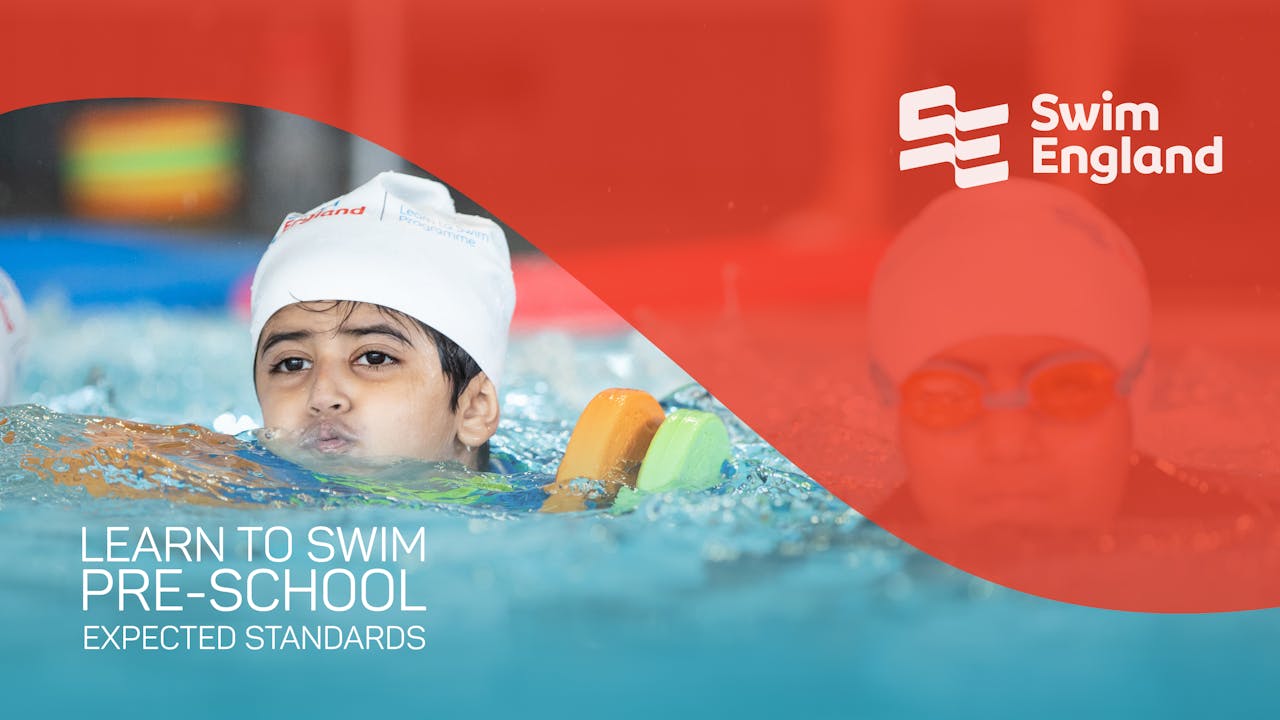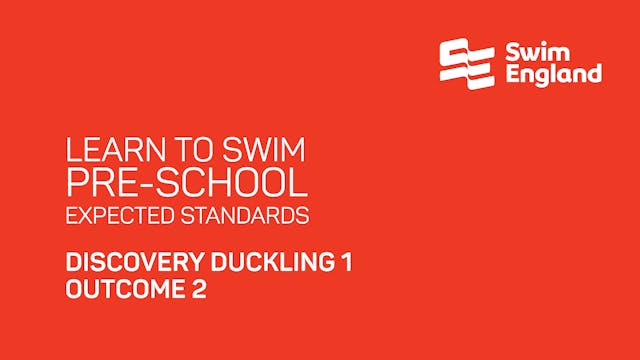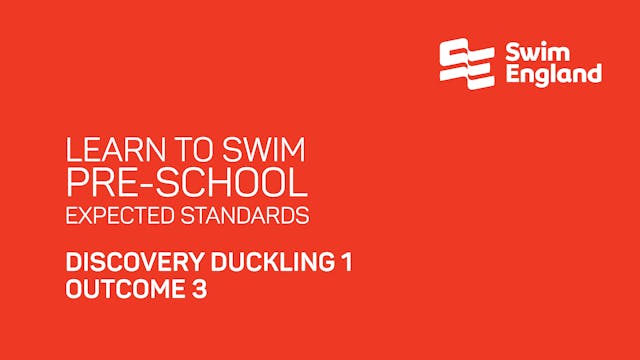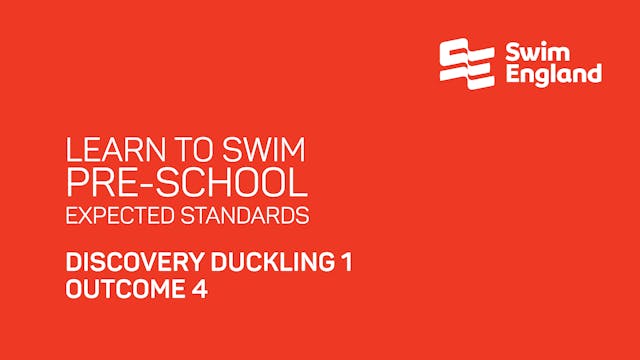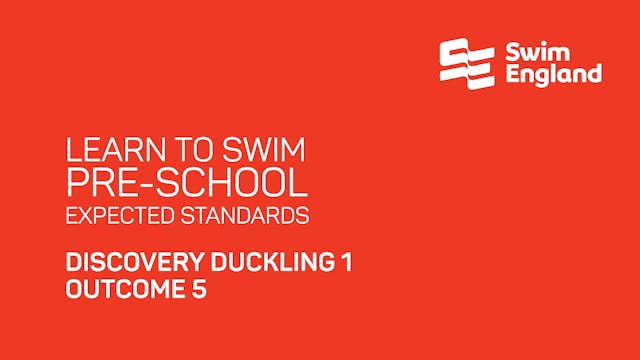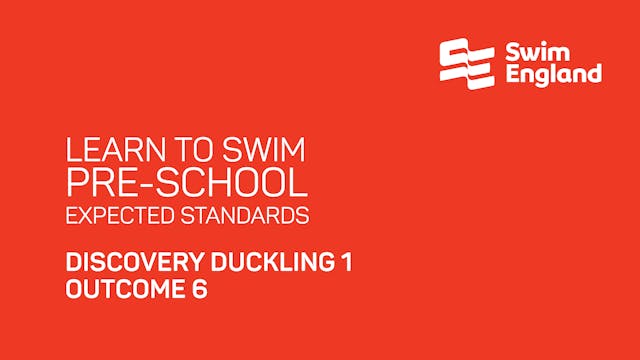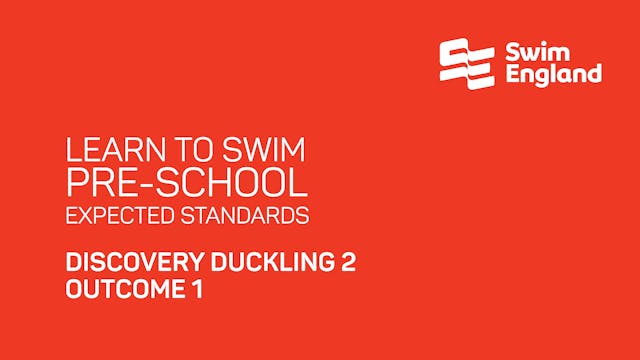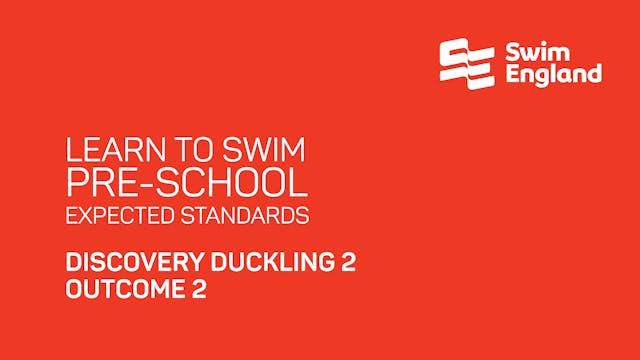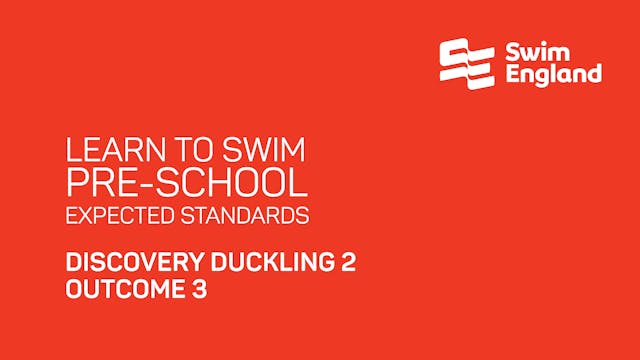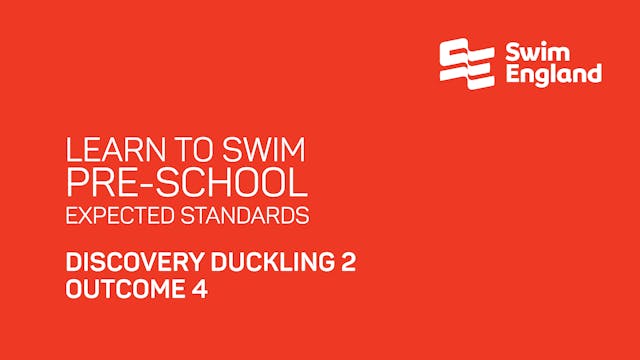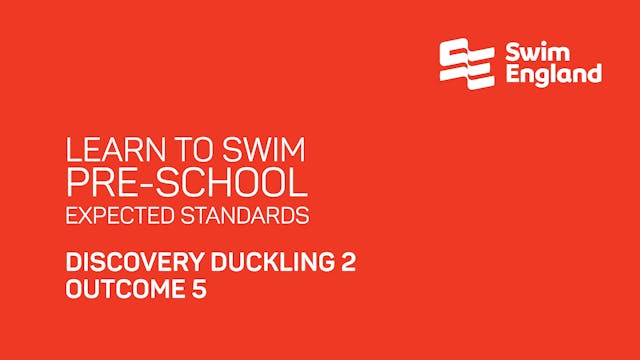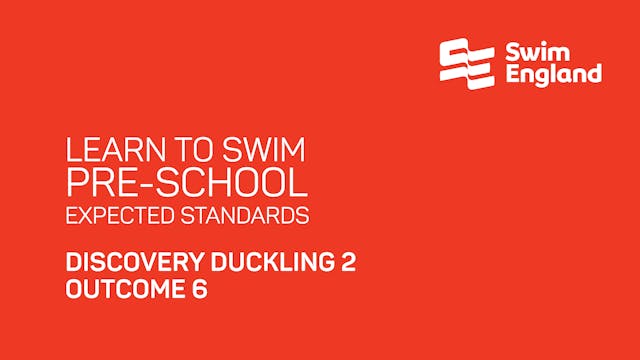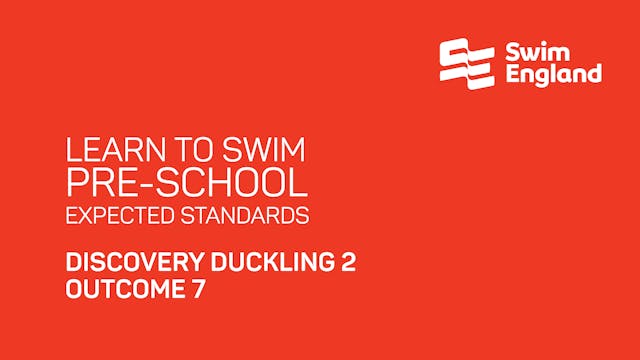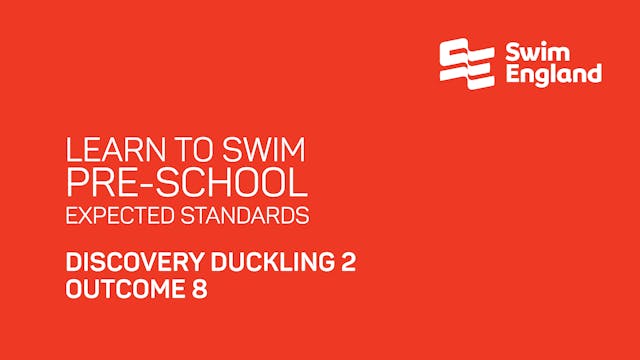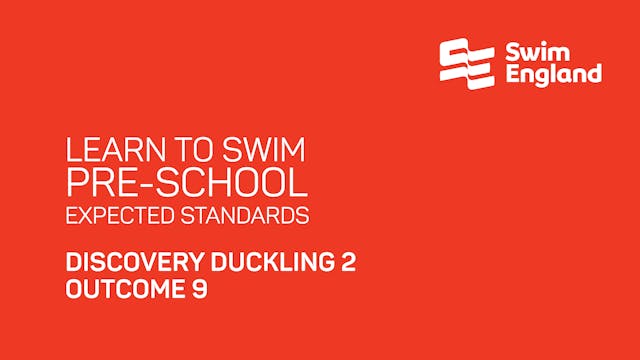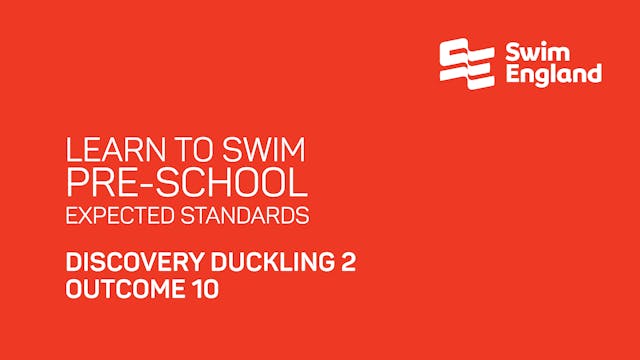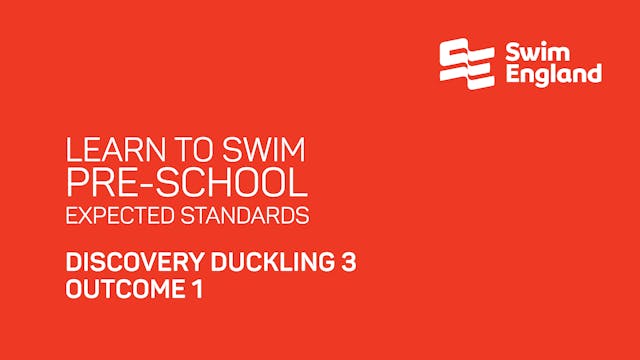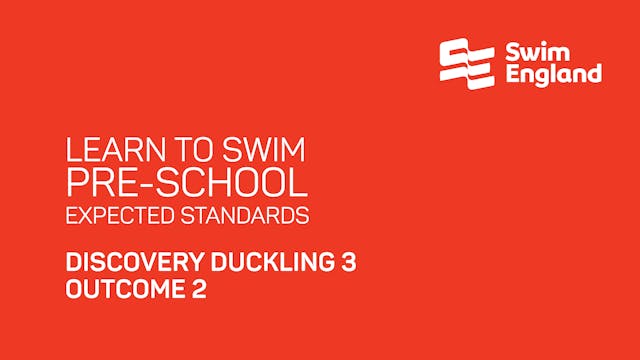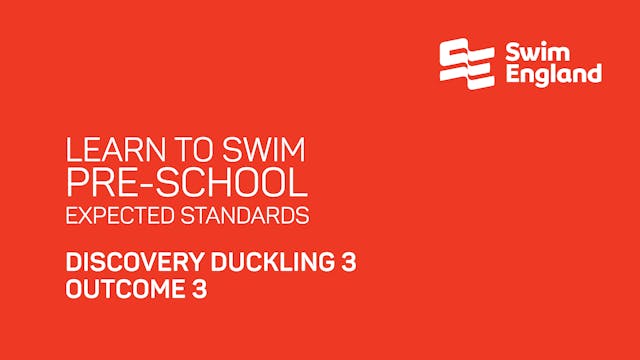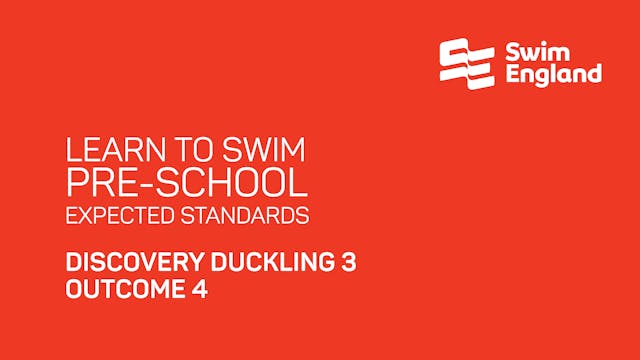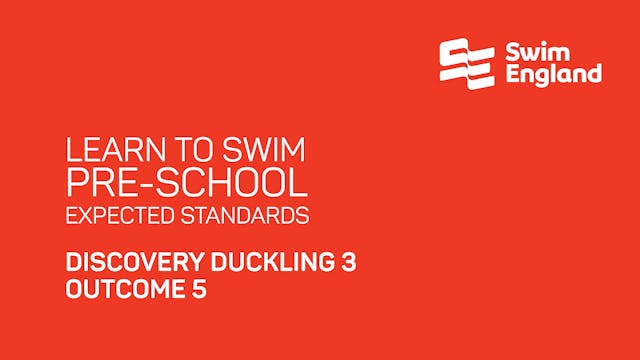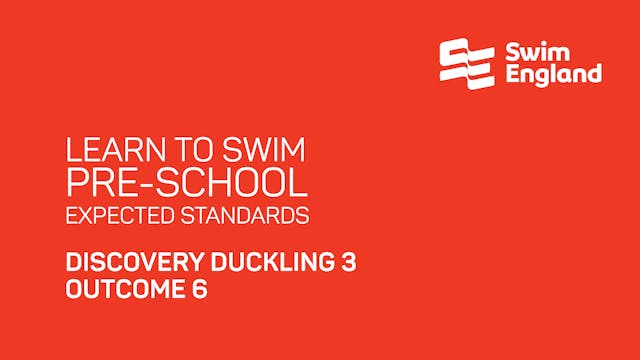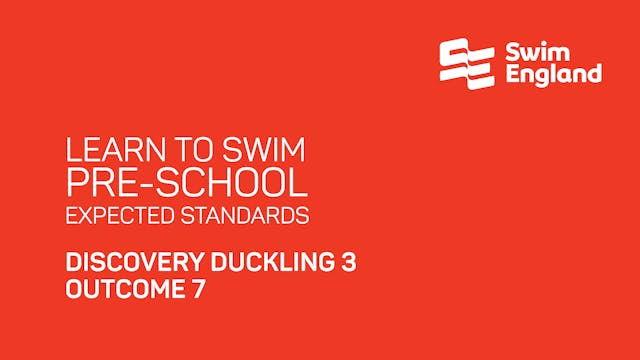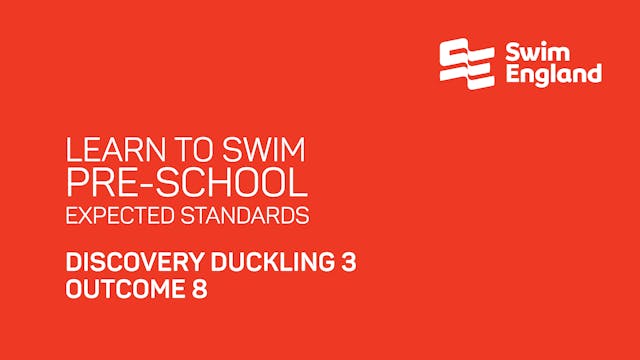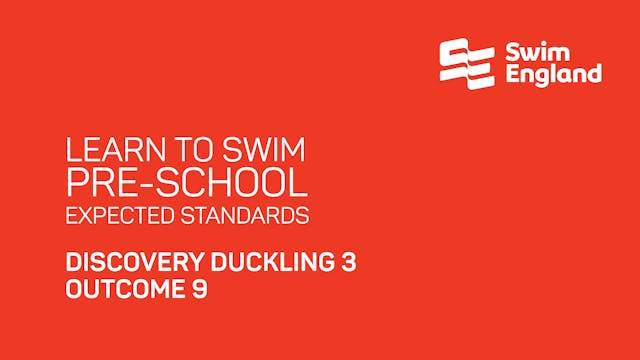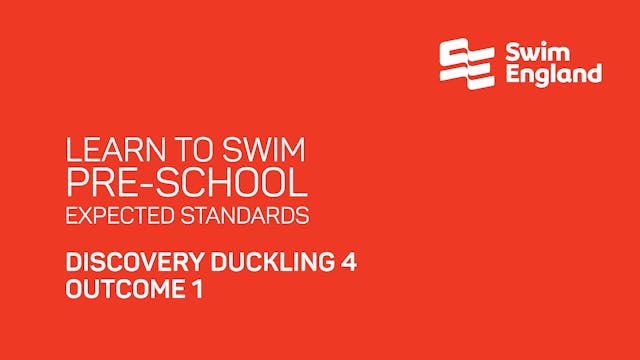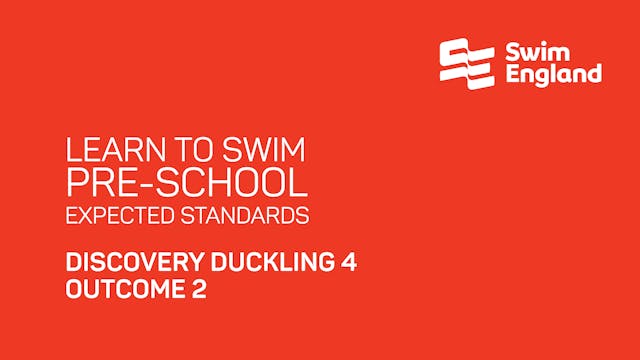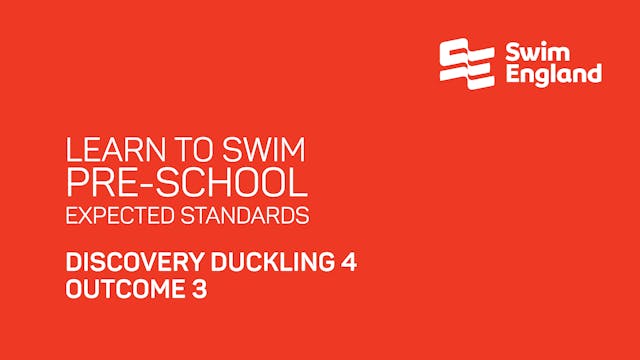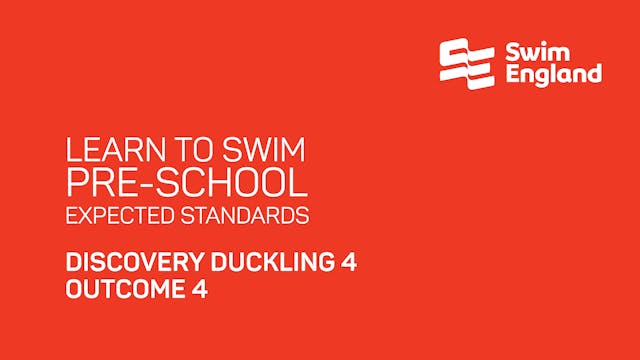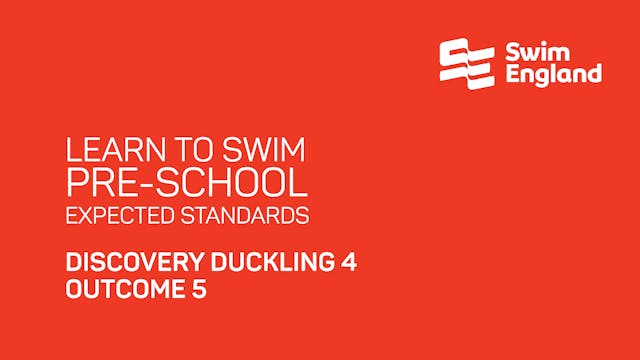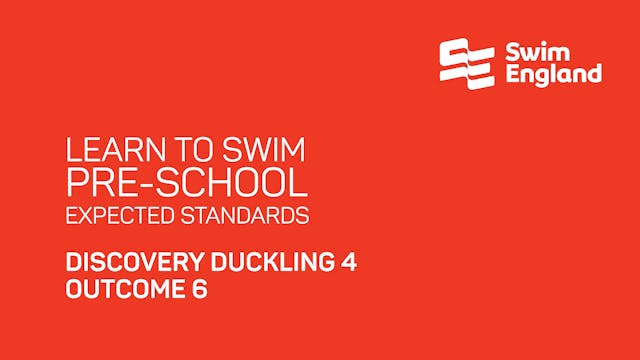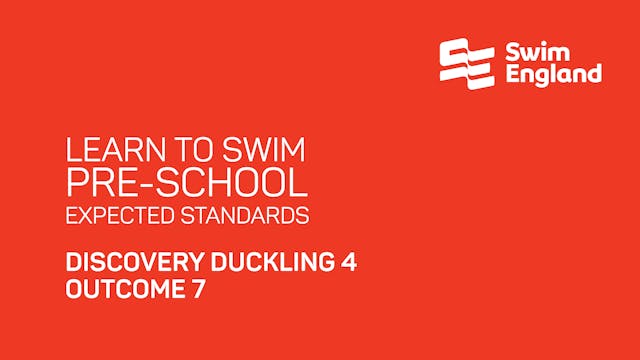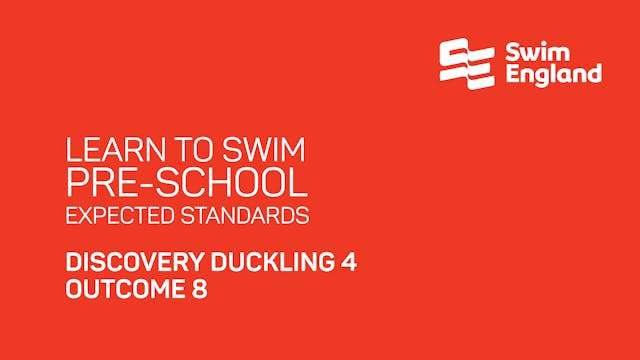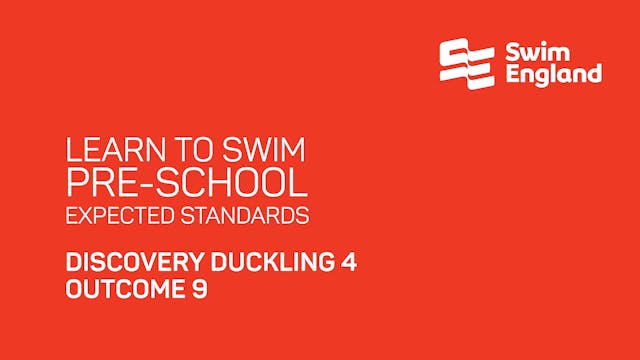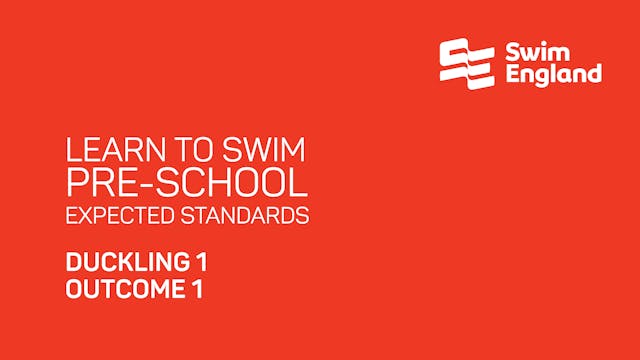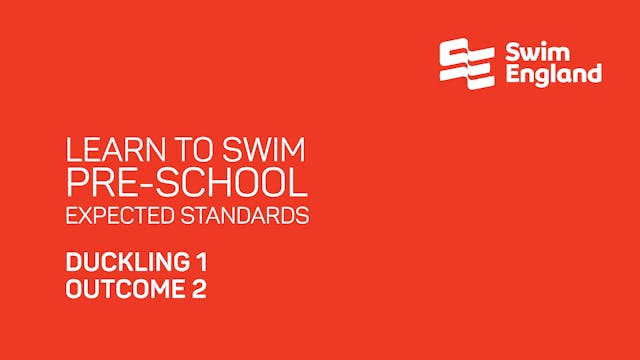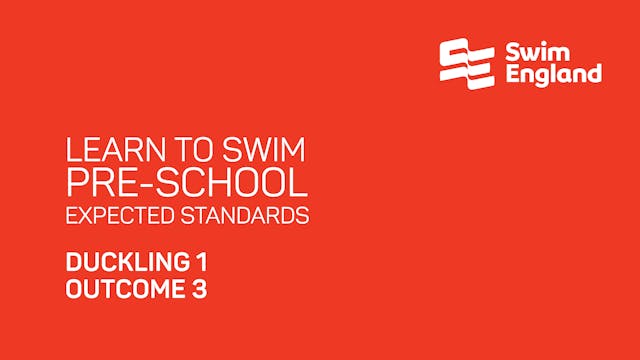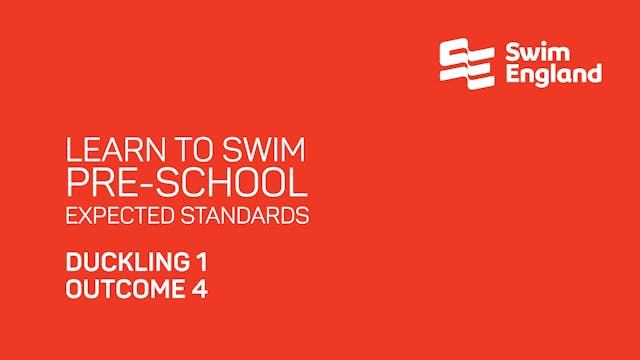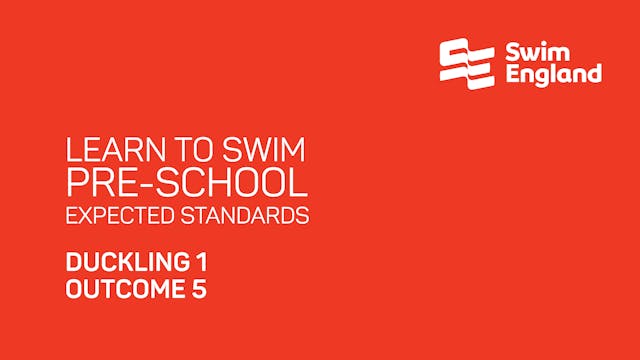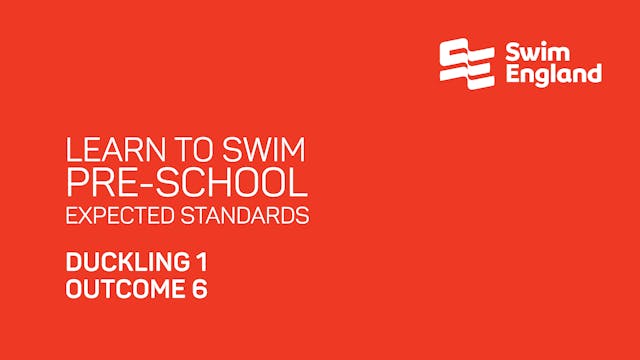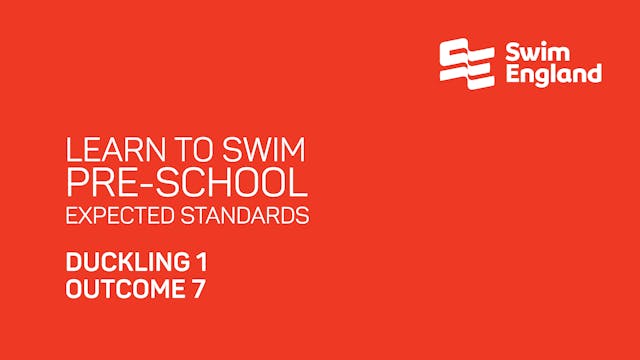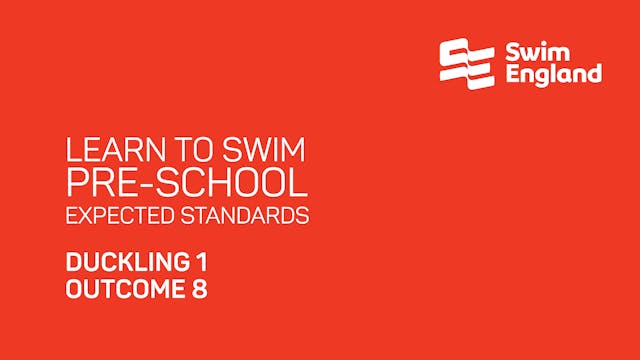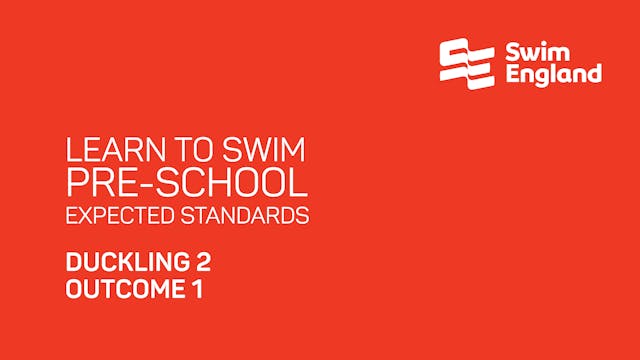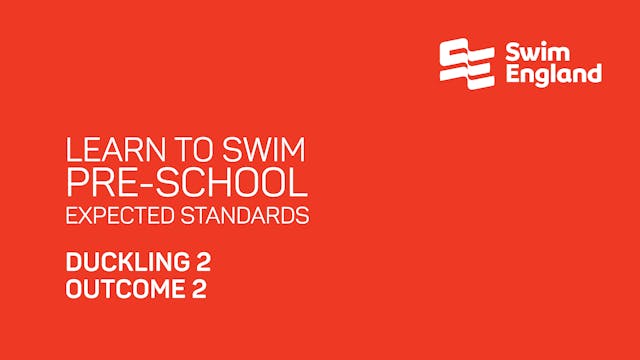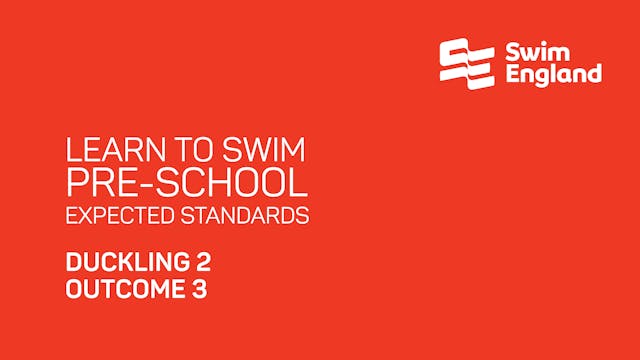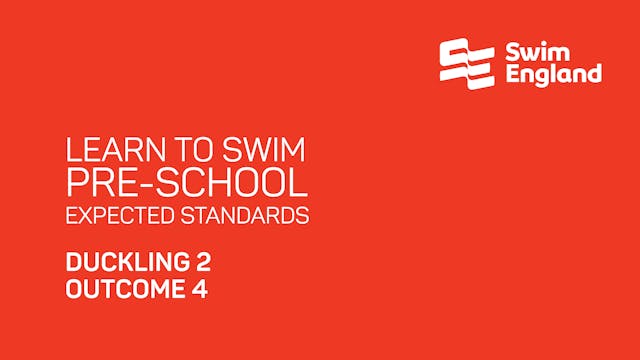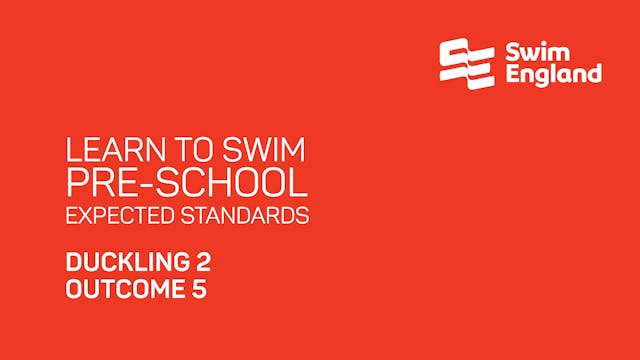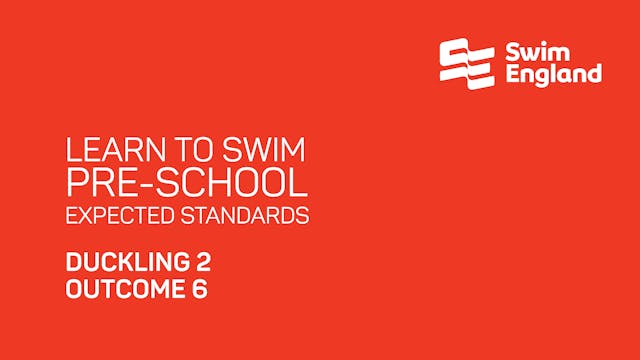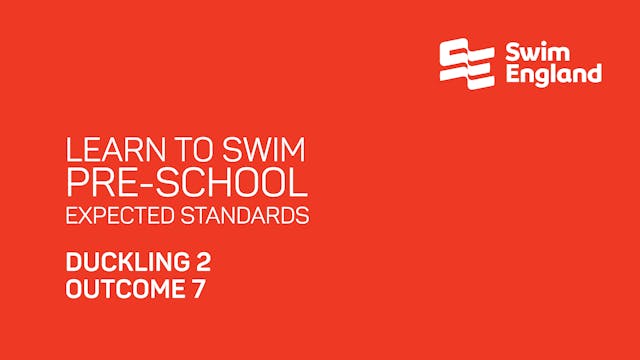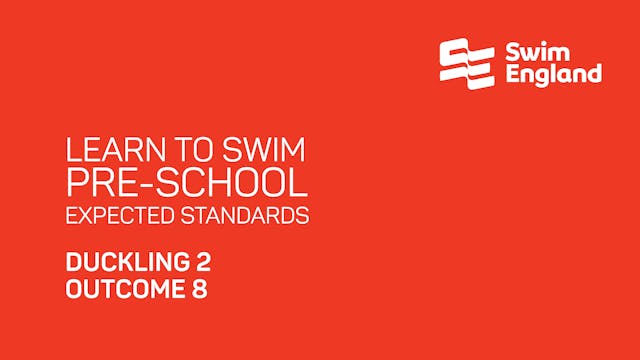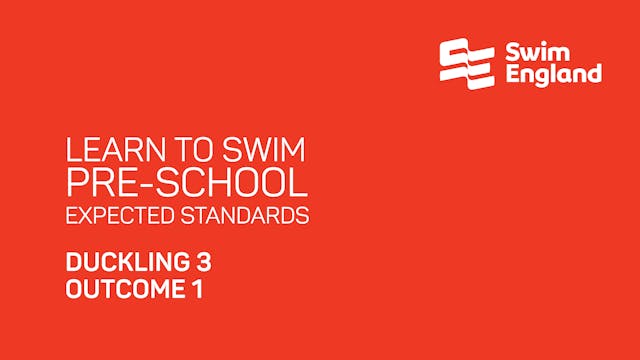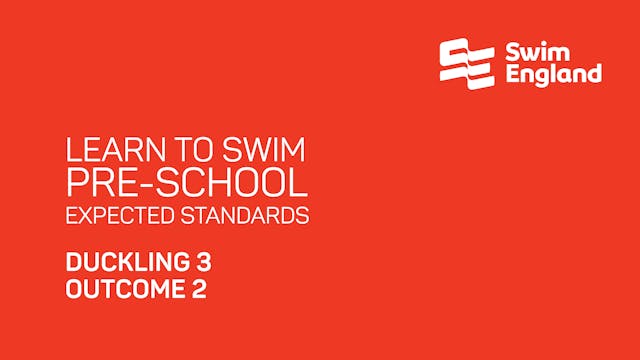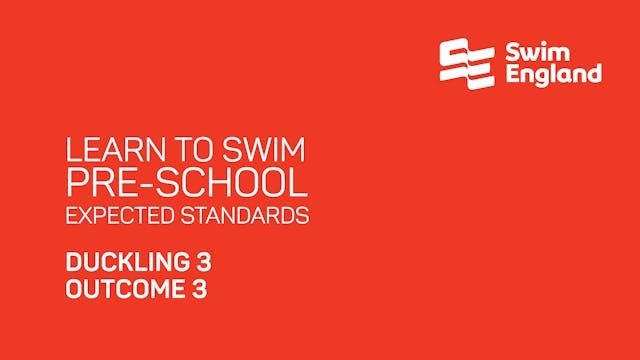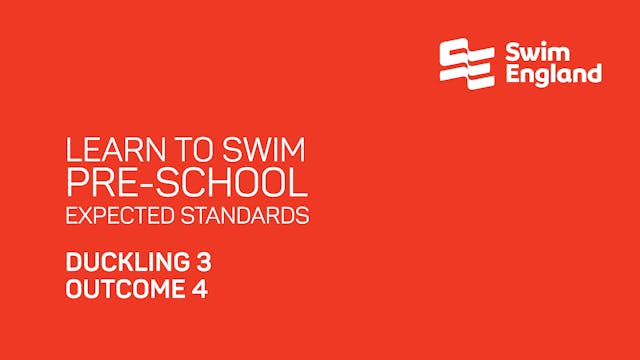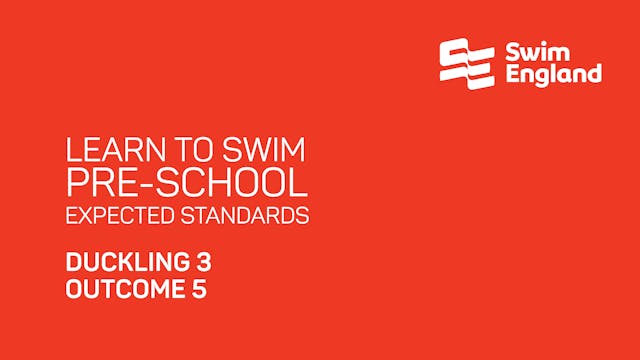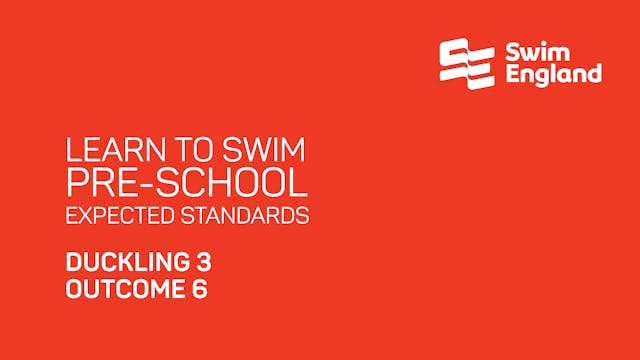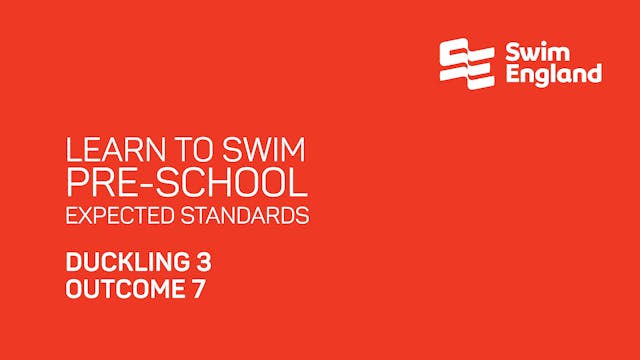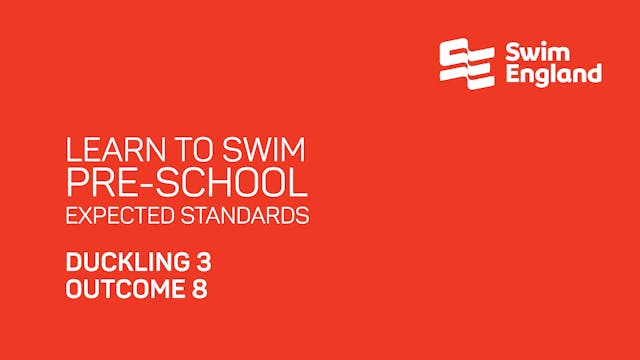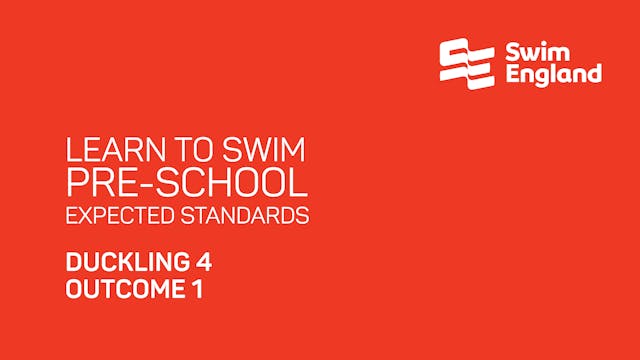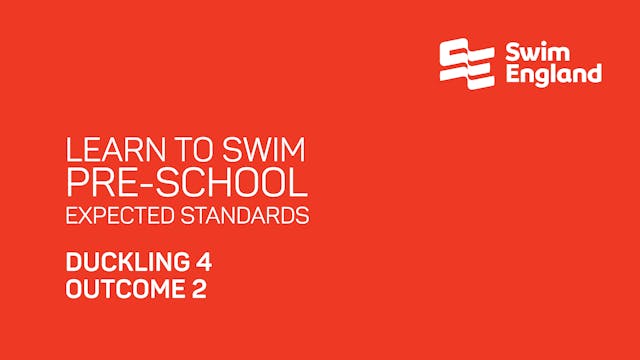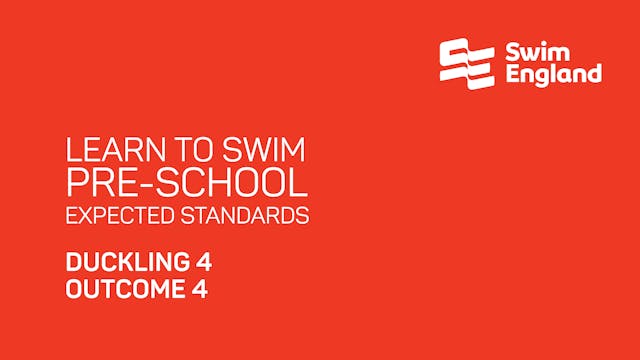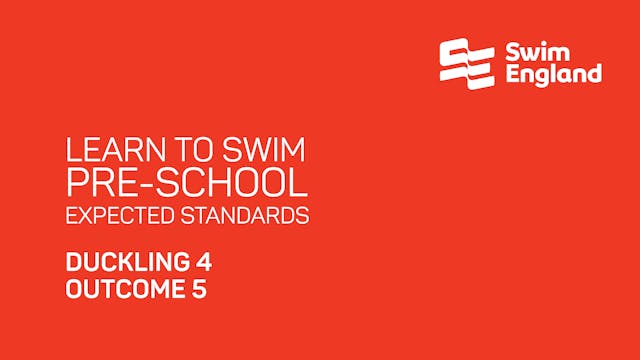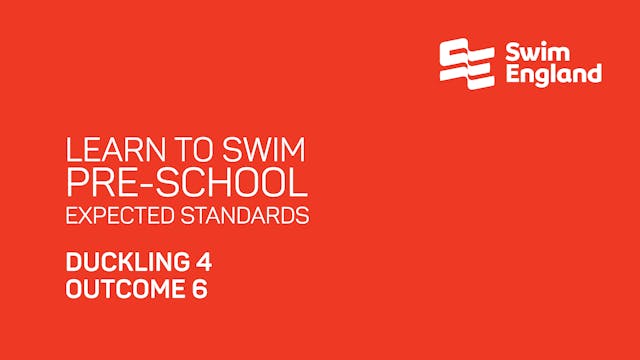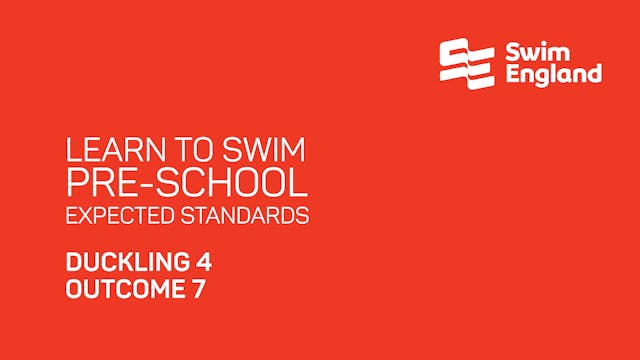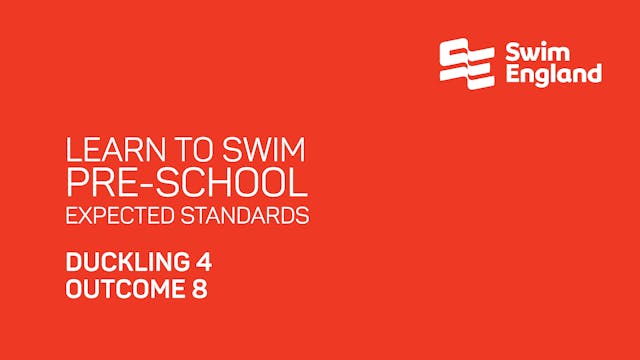Expected Standards Pre-School Framework
The Swim England Pre-School Framework is the first part of the Swim England Learn to Swim Programme. It promotes early water confidence and basic motor skills and underpins Stages 1-7.
This content may be used by you or your employees and be displayed for the benefit of students you are teaching. You may not otherwise copy, reproduce, distribute, publish, display, perform, modify, create derivative works, transmit or in any other way exploit this content or any part thereof without prior permission of Swim England.
-
Discovery Duckling 1 Outcome 1
For younger babies use a lying entry: the baby lies on a baby mat on poolside. The adult sits on the side and enters close to the baby without splashing. The adult then lifts the baby into the water under the armpits and with the head supported if needed.
For those who are able to sit, a sittin...
-
Discovery Duckling 1 Outcome 2
Adult to support the learner under the armpits with head support if required. Gently lift the learner up and back down to shoulder level in the water.
-
Discovery Duckling 1 Outcome 3
Learner to comfortably lie on the back fully supported by an adult using a cheek-to-cheek or yoke hold; return the learner to an upright position.
-
Discovery Duckling 1 Outcome 4
Adult to gently trickle/pour water over the back of the learner's head. A variety of equipment can be used: watering cans, buckets or cups.
-
Discovery Duckling 1 Outcome 5
Adults to move slowly around in the water with shoulders submerged fully supporting the learner in an upright position.
-
Discovery Duckling 1 Outcome 6
For younger babies use a lying exit. Or the accompanying adult must show they are able to safely exit the water, whilst fully supporting the learner.
-
Discovery Duckling 2 Outcome 1
For younger babies use a lying entry: the baby lies on a baby mat on poolside. The adult sits on the side and enters close to the baby without splashing. The adult then lifts the baby into the water under the armpits and with the head supported if needed.
For those who are able to sit, a sitting...
-
Discovery Duckling 2 Outcome 2
Learner to comfortably lie on the back fully supported by an adult using a cheek-to-cheek, shoulder support or yoke hold.
-
Discovery Duckling 2 Outcome 3
Learner to independently splash hands on the surface of the water.
-
Discovery Duckling 2 Outcome 4
(The adult should hold the learner close to them at first and then at arm's length. The learner should be facing away from the adult).
Whilst fully supporting the learner, the adult rotates in an upright position through 360 degrees. As the adult and learner gain confidence, the learner should m...
-
Discovery Duckling 2 Outcome 5
Learner to comfortably lie on the back, fully supported by an adult using a cheek-to-cheek, shoulder support or yoke hold. Once fully supported the adult will move backwards in the water supporting the learner to maintain a streamlined position.
-
Discovery Duckling 2 Outcome 6
Supporting adult to wash or splash water on the learner's face, either scooping the water using the hand, or trickling the water over the face using equipment such as a watering can, cup or bucket.
-
Discovery Duckling 2 Outcome 7
Adult to be at ease moving through the water supporting the learner in an upright position.
-
Discovery Duckling 2 Outcome 8
Learner to comfortably lie on the back or front fully supported by an adult using a cheek-to-cheek, shoulder support or yoke hold. Adult to then move comfortably forwards or backwards around the water with shoulders submerged.
-
Discovery Duckling 2 Outcome 9
Adult to fully support the learner and encourage them to hold on to the side of the pool or rail, by placing the learner's hands on the wall and then placing theirs on top. This can be encouraged through the use of games and placing toys on the side of the pool.
-
Discovery Duckling 2 Outcome 10
For younger babies use a lying exit. Or the accompanying adult must show they are able to safely exit the water, whilst fully supporting the learner.
-
Discovery Duckling 3 Outcome 1
Learners should be encouraged to sit on the side and wait for adult instruction. The learner sits on the side unsupported but under close supervision and is drawn in toward the adult in the water. The adult then returns the learner to poolside.
For younger babies use a lying entry: the baby lie...
-
Discovery Duckling 3 Outcome 2
Learner to comfortably lie on the back fully supported by an adult using a cheek to cheek, shoulder support or yoke hold.
-
Discovery Duckling 3 Outcome 3
Encourage the learner on their front to reach and grab toys scattered around the pool on the surface of the water, whilst the adult supports travel around the pool.
-
Discovery Duckling 3 Outcome 4
Adults to support the learner in completing the 180 degree rotation under the armpits. This can be done as a log roll from front to back or back to front or as an upright turn. The supporting adult will rotate the learner, without removing their hands, onto their forearm and back again.
-
Discovery Duckling 3 Outcome 5
Learner to comfortably lie on the front fully supported by an adult using a cheek-to-cheek, shoulder support or yoke hold. Once fully supported the adult will move backwards in the water supporting the learner to maintain a streamlined position.
-
Discovery Duckling 3 Outcome 6
Supporting adult to pour water on learner's face by using equipment such as a watering can, cup or bucket.
-
Discovery Duckling 3 Outcome 7
With the use of floatation equipment such as arm discs or noodles and, fully supported by an adult, the learner should move backwards using arms and legs.
-
Discovery Duckling 3 Outcome 8
With full adult support, the learner holds on to the wall or rail. The learner is then encouraged to move using a hand on hand motion toward the steps or ladder. Floatation equipment such as noodles or arm discs can be used along with full adult support.
-
Discovery Duckling 3 Outcome 9
Learner sits on the side unsupported but under close supervision. Another adult maintains contact with the learner whilst the participating adult climbs out next to the learner. For younger learners, use a lying exit. Or the accompanying adult must show they are able to safely exit the water, whi...
-
Discovery Duckling 4 Outcome 1
With full adult support. Learner sits or stands on the side unsupported but under close supervision and is drawn in toward the adult in the water. Adult then returns the learner to poolside.
-
Discovery Duckling 4 Outcome 2
With the use of floatation equipment such as arm discs or noodles and fully supported by an adult. The learner should remain in a flat position throughout.
-
Discovery Duckling 4 Outcome 3
On their front, encourage the learner to reach and grab toys scattered around the pool on or near the surface of the water, whilst the adult supports travel around the pool.
-
Discovery Duckling 4 Outcome 4
Using floatation equipment and with minimal adult support. Learner to rotate 180 degrees from a flat floating position using a log roll or in an upright position.
-
Discovery Duckling 4 Outcome 5
With full adult support, face and head either in or close to surface of water throughout. Start from a wall on front/back/face in/face out with arms to the side or above the head. Learner may choose to perform the movement towards or away from a wall.
-
Discovery Duckling 4 Outcome 6
Supporting adult to wet the learner's face by splashing or using equipment such as a watering can, cup or bucket. Learner to be at ease with chin resting in the water.
-
Discovery Duckling 4 Outcome 7
Learner to move with adult support if required with chin on the surface or face in the water. Arms and legs must be in the water and learner must use both arms and legs for the entire 5 metres.
-
Discovery Duckling 4 Outcome 8
With full adult support. The learner holds on to the wall or rail, and is then encouraged to move using a hand on hand motion toward the steps or ladder. Floatation equipment such as noodles or arm discs can be used along with full adult support.
-
Discovery Duckling 4 Outcome 9
Learner sits on the side unsupported but under close supervision. Another adult maintains contact with the learner whilst the participating adult climbs out next to the learner. For younger learners, use a lying exit. Or the accompanying adult must show they are able to safely exit the water, whi...
-
Duckling 1 Outcome 1
Learner sits or stands on the side unsupported but under close supervision and is drawn in toward the adult in the water. Adult then returns the learner to poolside.
-
Duckling 1 Outcome 2
The learner must take a deep breath and hold their breath to ensure they are floating at the surface of the water. Encourage the learner to stretch into a star float, maintaining the position with adult support behind the head.
-
Duckling 1 Outcome 3
Learner to confidently exhale at the surface of the water. Teacher must be able to see bubbles being blown.
-
Duckling 1 Outcome 4
Demonstration must show wetting the head in an activity whilst remaining calm throughout.
-
Duckling 1 Outcome 5
Learner should demonstrate long legs with a small splash, the kick originating from the hip and hips near the surface of the water. Floatation equipment can be used. The adult supports the head.
-
Duckling 1 Outcome 6
Travel may be with or without floatation equipment. Walking or paddling in deep or shallow water.
-
Duckling 1 Outcome 7
Learner sits or stands on the side unsupported but under close supervision and is drawn in toward the adult in the water. Adult then rotates and returns to poolside.
-
Duckling 1 Outcome 8
Learner may make use of a ladder or steps, beach pool approach, climbing, or use an adult to assist. A disability hoist may also be used.
-
Duckling 2 Outcome 1
Learner sits on the side under close supervision and is encouraged to turn onto their front and lower themselves in slowly. Adult support can be used if required.
-
Duckling 2 Outcome 2
Using floatation equipment and without adult support. Learner rotates 180 degrees vertically or horizontally without adult support. Floatation equipment may be used.
-
Duckling 2 Outcome 3
Learner to submerge face under the water with adult supervision. Eyes open with or without goggles.
-
Duckling 2 Outcome 4
Learner to travel through the water, chin on surface of the water, blowing an object for a distance of 2 metres.
-
Duckling 2 Outcome 5
Learner may use floatation equipment. Learner must move with their chin on the surface or face in the water. Arms and legs must be in the water and learner must use arms and/or legs for the entire 3 metres.
-
Duckling 2 Outcome 6
Holding onto the rail or wall with two hands, learner is to move sideways for 5 metres without adult support.
-
Duckling 2 Outcome 7
Start with a slide-in entry or a jump. This may be performed with or without submerging. Rotation to be around the vertical axis followed by returning to the point of entry and holding on to the side or rail.
-
Duckling 2 Outcome 8
Learner may make use of a ladder or steps, beach pool approach, climbing, or use an adult to assist. A disability hoist may also be used.
-
Duckling 3 Outcome 1
Start with toes over the edge of pool, jump upwards and forwards whilst eyes look forward throughout. Land feet first into the water. This may be performed with or without submerging.
-
Duckling 3 Outcome 2
Learner must take a deep breath and hold breath to ensure they are floating at the surface of the water. Star float or mushroom float can be used. Maintain the position without adult support.
-
Duckling 3 Outcome 3
A variety of methods may be used to demonstrate this including: hands on floor (as in beach area, stepped area or very shallow pool); floats; arm bands; hands holding the wall; feet hooked under bar whilst lying on the back; use of steps or a Level 1 Swimming Assistant may help the learner.
-
Duckling 3 Outcome 4
The learner must submerge the head or tilt the head downward with or without goggles. Learners may perform this whilst holding a wall, standing, with floatation equipment, or with adult support. The teacher must be able to see bubbles being blown.
-
Duckling 3 Outcome 5
Travel may be with or without floatation equipment or support, walking or paddling; in deep or shallow water.
-
Duckling 3 Outcome 6
Learner should demonstrate long legs with a small splash, the kick originating from the hip and hips near the surface of the water. Stretched arms with both hands on a float. Face may be in or out of the water.
-
Duckling 3 Outcome 7
Start with a slide-in entry or a jump. This may be performed with or without submerging. Rotation to be around the vertical axis followed by returning to the point of entry and holding on to the side or rail.
-
Duckling 3 Outcome 8
Learner may make use of a ladder or steps, beach pool approach, climbing, or use an adult to assist. A disability hoist may also be used.
-
Duckling 4 Outcome 1
Start with toes over the edge of the pool, jump upwards and forwards whilst eyes look forward throughout. Land feet first into the water. This may be performed with or without submerging.
-
Duckling 4 Outcome 2
Learner must take a deep breath and hold breath to ensure they are floating at the surface of the water. Maintain the position without adult support.
-
Duckling 4 Outcome 3
Learner to rotate 360 degrees, either horizontally or vertically using a log roll or an upright position. This can be achieved with or without floatation equipment.
-
Duckling 4 Outcome 4
Push and glide on the front or back, hands one on top of the other, arms extended, maintaining body alignment.
-
Duckling 4 Outcome 5
Learner must submerge the head completely with or without goggles. Learner may perform this whilst holding a wall, standing or with support of aids, equipment or support.
-
Duckling 4 Outcome 6
Travel may be with or without floatation equipment, equipment or support. Walking or paddling in deep or shallow water.
-
Duckling 4 Outcome 7
Start with toes over edge of pool, jump upwards and forwards whilst eyes look forward throughout. Land feet first into the water. This may be performed with or without submerging. Rotation to be around the vertical axis followed by returning to the point of entry and holding on to the side or rail.
-
Duckling 4 Outcome 8
Learner may make use of a ladder or steps, beach pool approach, climbing, or use a Level 1 Swimming Assistant to assist. A disability hoist may also be used if needed.

